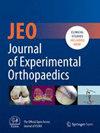High-grade medial femoral condyle and medial tibial plateau bone bruises predict ramp lesions of the medial meniscus in patients with anterior cruciate ligament tears: A prospective clinical and MRI evaluation
Abstract
Purpose
The purpose of this study was to evaluate potential predictive diagnostic variables on magnetic resonance imaging (MRI) for medial meniscus ramp tears in the presence of an anterior cruciate ligament (ACL) tear.
Methods
Patients aged ≥16 years undergoing arthroscopic anatomic hamstring single-bundle ACL reconstruction between July 2016 and September 2020 from a single centre were prospectively enroled with a diagnosis based on clinical and MRI evaluations. Demographic data such as age, gender, dominant limb and time from injury to surgery were recorded. Clinical assessments included Lachman and pivot shift tests. Imaging assessments involved grading bone bruises on MRI using the International Cartilage Repair Society (ICRS) scale. Statistical analysis was conducted using parametric tests and regression analysis with a p value of less than 0.05, which is considered significant.
Results
The final sample consisted of 108 patients, with a concomitant ACL tear and medial meniscus ramp tear present in 53 (49.1%) patients. In the univariate regression analysis, a higher grade of the medial femoral condyle and medial tibial plateau bone bruises was highly associated with the diagnosis of an ACL tear with a concomitant ramp tear (p = 0.006, β = 0.151 and p < 0.001, β = 0.172, respectively). In the univariate regression analysis, a higher grade of the medial femoral condyle and medial tibial plateau bone bruise was associated with the diagnosis of ACL tear with a concomitant ramp tear (p = 0.006, β = 0.151 and p < 0.001, β = 0.172, respectively).
Conclusion
In this prospective series of patients with ACL tears, 49% were found to have concomitant medial meniscal ramp tears. The finding of medial tibial plateau or medial femoral condyle bone bruising was predictive of ramp tear. The presence of this bone bruising pattern along with a high-grade Lachman and/or pivot shift examination, a medial meniscus ramp tear should be suspected.
Level of Evidence
Level II, prospective cohort study.

 求助内容:
求助内容: 应助结果提醒方式:
应助结果提醒方式:


